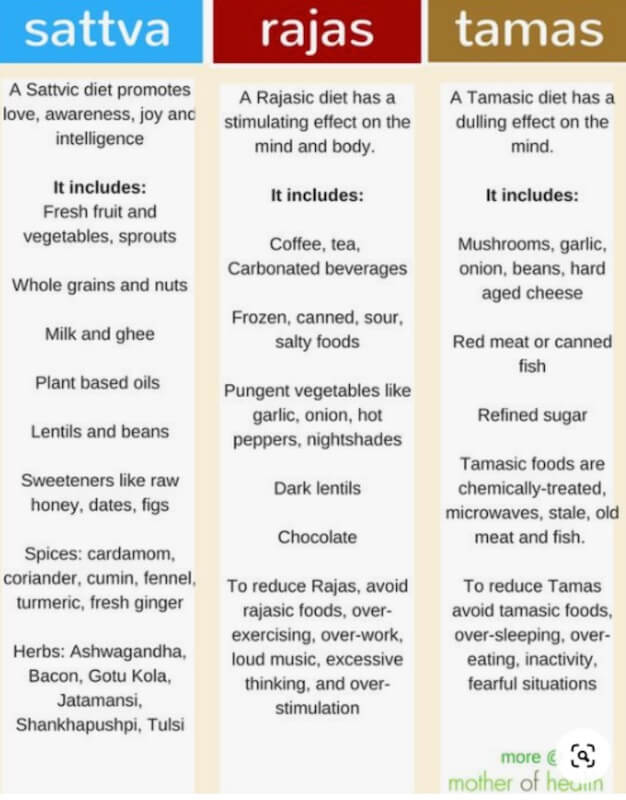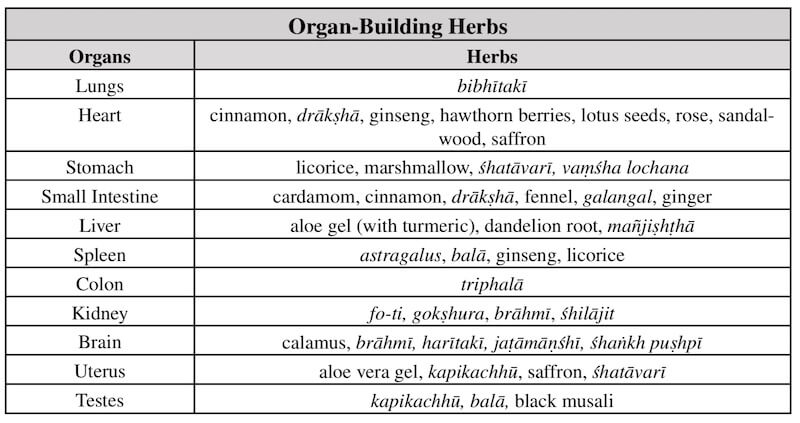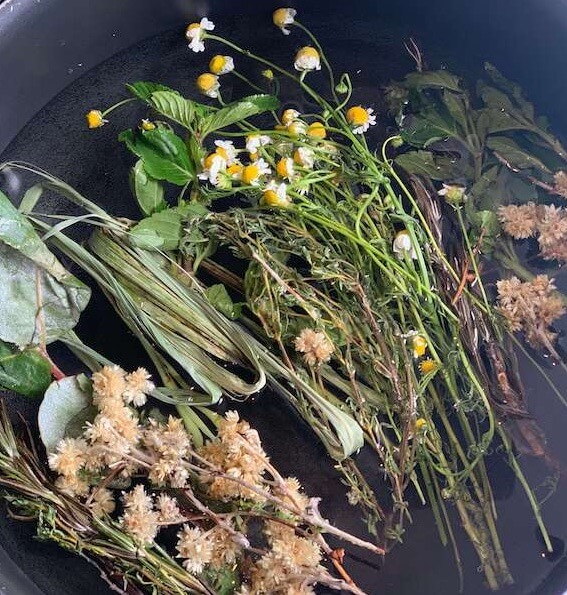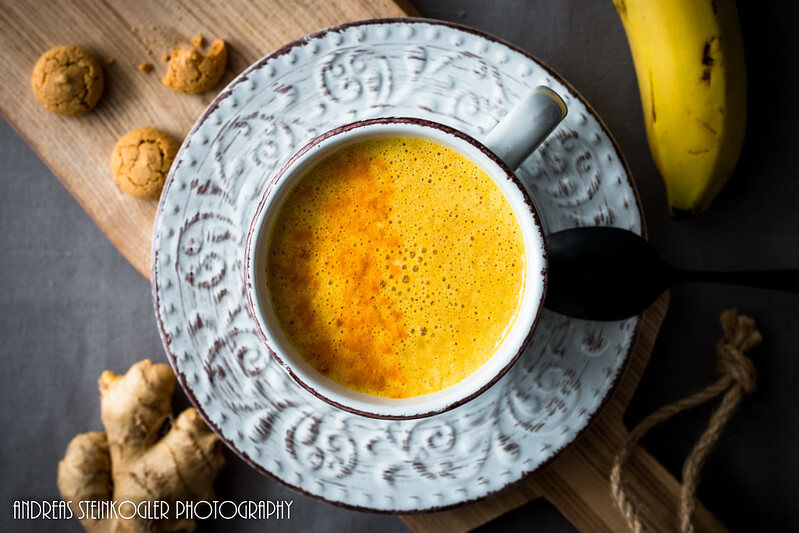Herbs and spices in a yogic diet - Part 1
Yoga , Nutrition / May 21, 2020 / 12 Minute Read / Comments
Yogic Diet
With about 80% of the world population enjoying a caffeinated product every single day, tea or coffee is more than a beverage, almost a religion. So, what about the rest of the 20%? Well, for those like me who had a strict upbringing, even chocolate milk was forbidden. Without any taste buds for chocolate, coffee or tea, it was quite difficult to acquire the taste in my early 20s when I first tried coffee and tea. Moreover, It was not a pleasant experience as my mind and body would start racing and get anxious. The body develops such sensibility to the extent that subtle changes can generate a noticeable impact over time. Same holds for stimulating and unhealthy foods too. According to the Hatha Yoga Pradipika of Sage Swatmarama (a 15th century manual that is like a Bible for Hatha Yogis), there are clear guidelines on the kinds of foods that yogis should and shouldn’t consume, particularly in the beginning of yogic practice. In this article, I will touch upon the yogic diet and the benefits of common herbs and spices in yoga and Ayurveda when used regularly.
Foods injurious and beneficial to a Yogi or Yogini in the Hatha Yoga Pradipika 1:62
“Bitter, sour, saltish, green vegetables, fermented, oily, mixed with til (sesame) seed, rapeseed, intoxicating liquors, fish, meat, curds, chhaasa (buttermilk), pulses, plums, oil-cake, asafoetida, garlic, onion, etc., should not be eaten. Food heated again, dry, having too much salt, sour, minor grains, and vegetables that cause burning sensation, should not be eaten.
Wheat, rice, barley, shâstik (a kind of rice), good corns, milk, ghee, sugar, butter, sugarcandy, honey, dried ginger, Parwal (pointed gourd), the five vegetables (mentioned in Gheranda Samahita: cucumber, eggplant, bitter gourd, jackfruit and figs, nuts and berries), moong, pure water, these are very beneficial to those who practice Yoga. A yogi or yogini should eat tonics (things giving strength), well sweetened, greasy (made with ghee), milk, butter, etc., which may increase humors of the body, according to his or her desire.”
A yogic diet is important to advance in yoga. Many other classical texts like the Gheranda Samahita, Shiva Samahita, Bhagavad Gita and Upanishads describe the yogic diet and seem to agree. Perhaps, only the Hatha Yoga Pradipika explicitly discards flesh foods as it is only implicitly mentioned in the other texts. Flesh foods are harder to break down, take longer to digest, putrefy during digestion, and put additional pressure on elimination and other bodily functions. Also, they stimulate the senses which makes it harder for the yoga sadhaka (practitioner) to meditate and reach higher states of consciousness.
Another important concept is “Mitahara” or moderation in eating, achieved through fresh, light and nourishing foods. Overeating is strictly prohibited in various texts. According to Hatha Yoga Pradipika 1:58, “The yogi should fill two parts of the stomach with food, and the third part with water, leaving the fourth part free for air to aid digestion.” Also, frequent fasting or undereating is discouraged. This is what yoga is about, balance, harmony and moderation. Yogic eating should not be a chore or a fad diet. It happens naturally when the body and mind are so synchronized that the desire to eat what is best for us arises naturally.
The three Gunas
In yoga and Ayurveda, the subtle aspects of a particular food, or any material thing in general, have been studied to such detail that they have been divided into three gunas (categories or qualities) based on their mind-body effects. It is even prescribed in the ancient texts that eating should be a silent, calm and mindful activity while cooking should be pleasant and joyful. Although the concepts of the gunas can be traced back to millennia with the initial references found in the Upanishads, the classification of different foods and ingredients below is quite modern, perhaps introduced first in the Hatha Yoga Pradipika.
Sattvic foods: The Bhagavad Gita, a classical text, defines sattva as: “When light and discernment dawn in this body, as well as in the mind and senses, then one should know that sattva is predominant.” Most seasonal vegetables, fruits, honey, nuts, beans, and grains are sattvic. Ideal for those on the yogic path because they raise the consciousness by helping one to see all living beings as an extension of the Self. Sattvic foods increase energy without stimulating the mind, are calming, light and easy to digest. Only to be eaten at half the capacity and appetite, following the principle of Mitahara.
Rajasic foods: Onion, garlic, chilis, caffeine, alcohol, eggs, high quality meat, overcooked, fermented and freshly canned foods. These stimulate and give a sense of a temporary high in energy levels only to crash once the effect has faded.
Tamasic foods: Meat, fish, foods that are stale, fried, reheated, and addictive substances. These generate laziness, inertia, and depressed mental state.
While not all the gunas may seem ideal, they are an integral part of our daily life, each has their own place and time of need. There are no strict rules as long as moderation and personal limitations are taken into account. For instance, a rajasic diet might be well-suited for a physically demanding and laborious lifestyle. The only advantage of tamasic foods is sleepiness, satisfying cravings or the ease of comfortable reheating when we are too lazy to cook. Hence, those really interested in physical and spiritual growth should consume sattvic foods.
 |
|---|
| Source: https://motherofhealth.com/what-is-sattva |
How about incorporating more of a light, plant-based diet as a substitute or addition to the more rajasic or tamasic foods? In some religions like Jainism, there is a whole new level of sattvic food, as a ‘clean’ diet is taken very seriously. Traditional Jains not only refrain from eating onion and garlic because of their tamasic quality but also roots, tubers, mushrooms, yeast, and stale foods – These are believed to contain higher concentrations of insects and microorganisms following the yogic principles of sattva and non-violence (ahimsa). Despite diverse diet choices, herbs and spices are pretty versatile and people from almost all cultures, religions and traditions have been using them as early as 4000 CE.
Herbs, spices and Sattva
For those on the yogic path or not, herbs and spices are important in aiding the mind and body. Naturally, anything that helps with mental, physical and emotional equanimity in yoga is considered sattvic. Most herbs are sattvic whereas some spices are rajasic because of their stimulating properties. While herbs and spices are complementary, the difference lies in the part of the plant that they come from. Herbs are the green leafy parts whereas spices can come from any other part like the seeds, fruits, roots, or stem.
Daily use of common herbs and spices like ginger, turmeric, holy basil (tulsi), pepper, cinnamon and cardamom for disease treatment and prevention is beneficial for all. For those practicing yoga, these subtly stimulate the prana, increase the digestive fire (Agni) and create higher awareness.
 |
|---|
| Picture from https://www.flickr.com/photos/sammyjayjay |
In fact, Ayurveda sings praises about the healing properties of herbs and spices when consumed regularly, as testified in a recent interview I shared about the role of yoga and Ayurveda to fight COVID-19. Needless to say, I am a big fan of fresh herbs and often scout markets to find eclectic herbs that I can use for cooking or brewing. As for spices, I get my stock from the land of spices everytime I visit India. Thanks to globalization, there is no need to risk 15,000 kms over treacherous seas like they did in the Spice Route Era. I often turn to herbs for their soothing effects during all kinds of sick and happy moments.
While Ayurveda emphasizes the use of thousands of herbs for different ailments, below are some organs that particular herbs might benefit. A lot of these could sound too foreign, but they are very common Ayurvedic herbs and you would be surprised at how easily they are available online. Please remember that this is not medical advice, but just a general guide for informative purposes. They could cause side effects if combined with other medications and if you’re allergic or sensitive to any of the below herbs.
 |
|---|
| Source: The Ayurveda Encyclopedia by Swami Shiva Tirtha |
Empowering Herbs
Based on classical texts, The Ayurveda Encyclopedia mentions a well-kept secret to empower the healing power of herbs in particular. “When herbs are mixed or prepared, a bíj (seed) mantra is often recited to empower the herb’s properties by enlivening all five elements: ether, air, fire, water, and earth. Bíj are the essence of all other mantras. Thus of all the mantras, they have the most power. One such mantra is
Aum Ing Hring Shríng
Klíng Sanga Shamboah Namah
This mantra can be repeated once, seven, 31, or 108 times. It may also be repeated in intervals of 108 times. The number 108 is a mystical number in the Vedic sciences. Thus, chanting 108 times further empowers the herbs.”
My favorite herbs and spices
For non-caffeinated people like myself and caffeine addicts alike, herbal infusions are a great alternative to soothe and heal the body and mind. From immune-boosting to calming properties, herbal infusions are unsung heroes for natural relief. The extensive use of herbs in most branches of alternative medicine and the sacred nature of specific herbs in various religious or spiritual contexts is no secret.
 |
|---|
Recently, we acquired a variety of herbs from the supermarket like eucalyptus, mullein, mint, rosemary, thyme, chamomile and lemongrass. When life throws a lot of herbs, I make chutneys boil them into a unique herbal infusion and the results seldom disappoint. At other times, we really enjoy just a plain ol’ soothing cup of chamomile or ginger tea. I would clarify that the word ‘herbal tea’ has nothing to do with regular caffeinated tea or the tea plant that contains even higher levels of caffeine than unbrewed coffee beans. When I say ginger tea, for instance, I am referring to ginger boiled in water.
While volumes have already been written about the benefits of herbs and spices, I had to put my own yogic spin. I self-experiment because the greatest of laboratories is our body when respected and recognized. Note that I have incorporated mostly facts that have been proven scientifically for each herb. I recommend fresh over dried herbs and spices because they are unprocessed, light, and straight from the actual plant. All of these pair deliciously with some lemon and honey when steeped in hot water. Remember that yoga is all about moderation and balance, so it would be great to exercise precaution and know individual limitations when consuming anything.
Growing up, I was prohibited to drink chocolate milk. So, I never really acquired a taste for chocolate, coffee, or tea. Since I would frequently have a sore throat, my mother would only give me milk tinted yellow with turmeric and nut powder with cardamon (milk masala) every morning. I will mention the benefits of some of my favorite herbs and spices in this article, but with so many out there, I will also mention more in Part 2 of this article. Of all herbs and spices, turmeric holds special place in my heart:
 |
|---|
| Picture from https://www.flickr.com/photos/andreassteinkogler/ |
-
Turmeric: Sattvic. Last year at the SXSW Wellness Fest, I was overwhelmed with turmeric lattes and juices. An every-day staple ingredient found in every Indian household even before the common era, turmeric is just now making an arrival in the West. Why is turmeric so amazing? Curcumin, the active ingredient is anti-inflammatory, antioxidant-boosting, promotes blood circulation, and may prevent cancer, alzheimers, arthritis and heart disease. According to a study, consuming black pepper with turmeric increases the absorption of curcumin by 2000% and prevents its rapid metabolism in the liver and intestinal wall.
Just a couple of days ago, in the kitchen, I cut my thumb pretty deep and remembered as I was taught since childhood, to sprinkle turmeric powder on the cut. The oozing blood stopped right away and once a day turmeric application caused my wound to completely heal four days later. Many studies have been conducted on its wound-healing properties. Fresh turmeric is easily available in supermarkets and I pickle julienned slices with fresh ginger in salt and lemon water for garnishing anything from sandwiches to curries. As for yoga, it also balances the digestive fire to access the higher layers of the mind and prana (vital energy).
-
Ginger: Sattvic. My go-to for fevers, colds and sore throat, drinking grated fresh ginger tea is so soothing for the throat as its active ingredient gingerol is anti-inflammatory and antioxidant. It also helps with digestion, nauseas and is great to boost immunity. For yogis, ginger water taken regularly aids in flexibility, vitality, and digestion. Most of my kitchen experiments include this indispensable power weapon: ginger and garlic paste. In the recipe I recommend, salt is optional but I prefer adding it to increase the shelf life and cumin seeds to enhance the taste.
-
Garlic: Rajasic. I will go out on a limb with this one as garlic falls in the rajasic category because of its stimulating and heating effect. While its medicinal use is praised in Ayurveda, regular consumption in big amounts arouses strong emotions so it is not ideal for spiritual and mental uplifting. A lot of yogic traditions and even some Indian religions advise not to consume garlic at all but I still think that consuming it in small quantities can be therapeutic, especially because of its heart-healing, anti-inflammatory, and antibiotic properties. Finally, yoga is about moderation – balancing rajas and tamas with sattva is the goal. So, the medicinal use of garlic is even permitted in yoga. A sore throat remedy that I use involves putting on a tablespoon one clove of garlic, half teaspoon of turmeric, honey, and lemon juice and chewing them up before going to bed. It never fails, and I wake up without a sore throat but with a strong garlic odour :)
-
Tulsi (Holy Basil): Sattvic. Native to India, this ‘queen of herbs’ is so potent, it is sacred. Many Hindu households in India have a special raised structure for the tulsi plant and it is worshipped every day. Anti-microbial, calming, anti-diabetic, and adaptogen, tulsi is also an insect repellant. Tulsi tea has been compared to “fluid yoga” and its “regular consumption may be compared with the regular practice of yoga.” It acts as a tonic to nurture the body, stimulate sensory perception, and calm the mind.
-
Chamomile: Sattvic. After several attempts to find it at grocery stores in Russia in vain, we were finally led in on the secret: It’s only sold at pharmacies! Such is the power of this soothing and subtle herb that it is our go-to for acid reflux or gastric problems. Chamomile is often used as a sleeping and calming aid, provides relief for premenstrual syndrome and type 2 diabetes. Pairs very well with lavender.
-
Mexican Mullein (Gordolobo): A recent super-market find, this was my first time coming across mullein or gordolobo, as it is popularly known in Mexico. This unsung hero is generally used for respiratory infections, many skin conditions, ear infections and some gastrointestinal disorders.
-
Eucalyptus: As a child, inhaling eucalyptus oil vapor or dabbing a drop on the nose for bad colds leaves an unforgettable olfactory memory of this strong herb that I just got to use fresh for the first time. Anti-microbial, immune-boosting, insecticidal and pain relieving properties of eucalyptus make it beneficial for respiratory to dental problems.
I can go on and on with this list as there are just way too many natural options in the plant kingdom that are power-packed for enhancing immunity and treating the entire body with little to no side effects. Their subtle yet healing nature is holistic when combined with a healthy lifestyle and they work best when used as preventive aids. The best part is that a lot are found in any fridge or pantry and when used judiciously, herbs and spices are some of the most cost-effective and healing medicines. Instead of buying processed and sugar-loaded pickles, sauces, dressings or marinades, try creating your own with fresh herbs and spices. Instead of tea bags, opt for fresh herbs.
However, just eating healthy is not a recipe for instant awakening. It is just a part of the holistic approach to life. Exercise, work, spirituality and meditation complement the diet and constitute a healthy and joyful existence. What if doctors and governments would start recommending a holistic lifestyle that prioritizes a healthy body and mind by inspiring people to connect with their true Self, nature, and nurture their higher consciousness? The world would certainly be a better place, and we could just build enough immunity to sail through a pandemic. Stay tuned for Part 2, as I will be sharing more on herbs and spices, especially the spice box that is found in every Indian household.